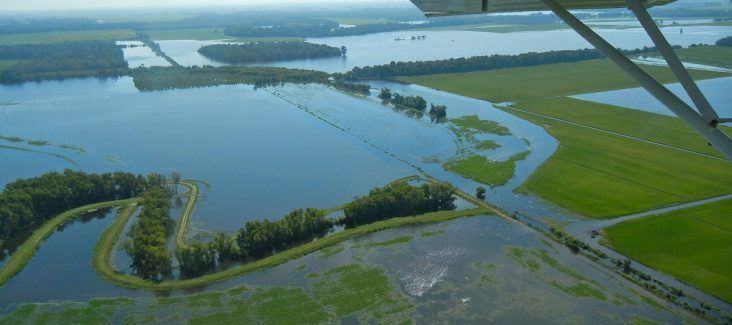Historic flood may doom many row-crop farmers in Northeast Arkansas
by September 8, 2016 4:32 pm 424 views

(Photo courtesy of Lauren Geurin)
Fourth generation farmer Jerry Morgan was sitting in church when he had a sudden epiphany. It had been raining for days, and there was equipment out in the fields that needed to be moved. It was Sunday night, and he left with his brother to save what he could. The Black River was about to blanket his soybean and rice fields near the town of Lynn.
Nearly 15-inches of rain inundated Northeast Arkansas in mid-August, and it caused millions of dollars in damage, according to the University of Arkansas Division of Agriculture. Farmers suffered up to $50 million in row crop losses, and like the river, the costs could rise much higher. Rice farmers could lose $18.6 million alone. For many farmers along the Black River it will be the last time they harvest a crop, if the federal government doesn’t help, Morgan told Talk Business & Politics.
“I’m 58-years old, and I’m tired of it,” Morgan said. “When we harvest this crop there won’t be enough to pay the bank back.”
Low commodity prices coupled with high production costs in recent years have turned small town farming into a break even enterprise at best, Morgan said. When the flood waters began to rage almost a month ago, it was a death knell to many. Insurance will pay for a portion of those losses, but it’s not nearly enough, he said. Farmers are offered low interest loans, but that’s no solution either, he said.
“We can hardly pay back the loans when the weather is good for a season,” he said. “How would we pay back hundreds of thousands of dollars on top of the loans we already pay each year? I’m not taking out a low interest loan. I’m not doing it.”
Soybean crop losses will total nearly $10.75 million in five counties in Northeast Arkansas, according to estimates. Lawrence County farmers topped the list with about 12,000 lost soybean acres, while Randolph County farmers lost about 8,000. Up to 75% of soybeans planted on flooded acres are not harvestable.
At least 40,000 rice acres were lost. Randolph County rice farmers lost an estimated 15,000 acres, followed by Craighead County with about 10,000 acres. Two other crops should be fine. Corn was ready to harvest, and the 20,000-acre peanut crop was primarily planted in Mississippi County this year on well-drained soil, meaning damage from the rains should be minor.
Cotton losses in the region could top $11.5 million, but there is uncertainty about how much damage there was to the cotton fields, according to the study. Farmers lost about 70% of the cotton planted in late March and April because of the floods, but those crops only make up 1% of the state’s 370,000 cotton acres. Crops planted later should not be impacted by the rains, the study stated.
Agriculture is the largest business in Arkansas. It accounts for nearly $20 billion per year in the state. Arkansas is the leading rice producing state in the country. University of Arkansas extension economist warned the losses may be much higher than these estimates.
“At this stage it’s difficult to gauge the impact of quality deterioration and need for segregating damaged crops to avoid contamination of the non-damaged harvest,” he said. “Finally, the estimate does not include the damage incurred on small and large vegetable and melon farms.”
A major problem is developing in the Lawrence County rice fields, extension chair Herb Ginn told Talk Business & Politics. Rice heads are sprouting, which means the quality of the rice crop harvested could be severely compromised, he said. It’s a problem that extends far beyond the flooded river fields.
“I’ve talked to farmers who’ve been in the fields their entire lives and they’ve never seen sprouting rice heads. This is a real problem … there is the potential that all of this could get much worse.”
For farmers like Morgan they’re already on the brink. At the beginning of the year, Morgan planned to farm about 4,400 acres. If he’s lucky he’ll get to harvest about 1,200 acres. The problems are more than just the summer floods, he said.
Earlier in the spring, flood waters wiped out the early soybean crop and it had to be replanted in late June. Soybeans planted that late typically produce smaller yields to begin with, Morgan said. Farmers who had to replant were already bracing for a deep financial hit, he added.
“We were facing losses before the weather damage … the last two years we’ve been trying to just survive. I’ve talked to farmers all up and down the river. If we don’t get some kind of help a lot of us may not survive this.”
